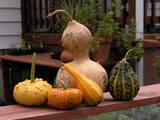 Gourds. For thousands of years, gourds have been grown and used by many cultures as useful tools and utensils. Today we mostly think of gourds as decorations and whimsical birdhouses or containers.
Gourds. For thousands of years, gourds have been grown and used by many cultures as useful tools and utensils. Today we mostly think of gourds as decorations and whimsical birdhouses or containers.
Gourds are close relatives to pumpkins, squash and other vegetables in the Cucurbitaceae family, like cucumbers and melons. And they are just as easy to grow.
There are 2 basic types of squash that are grown and used decoratively:
- Cucurbita or soft-skinned gourds – These are the colorful orange, gold and green gourds that look like small squash and come in odd, fun shapes. Cucurbita gourds are usually used fresh as wonderful fall decorations. They are beautiful as is and can also be carved and used as luminaries, flower pots or dishes. They can also be dried and saved, but their bright colors will begin to fade in a few months.
- Lagenaria or hard-skinned gourds – These larger, utilitarian gourds include the familiar Birdhouse, Bottle and Dipper gourds. Hard skinned gourds grow green on the vine and eventually turn the familiar shades of tan and brown, as the shells dry. Interestingly, Lagenaria gourds have white flowers that bloom during the night, unlike the usual yellow blossoms of most squash that we see during the day.
Harvesting Ornamental Gourds:
Whatever type of gourd you are growing, it is ready for harvesting when the stems dry out and turn brown. Cut the gourds with a few inches of stem intact. Harvest all gourds before a hard frost. Immature gourds will not last long, but frost will ruin soft skin gourds entirely and even a light frost can alter the color of hard skin gourds and affect their ability to dry.
Discard bruised and spoiled gourds. They will just begin to decay in storage.
Curing Ornamental Gourds:
Curing or drying ornamental gourds requires time. There is no shortcut, like micro-waving. The outside of the gourd must dry completely and then it will take another several months for the inside of the gourd to dry and cure. Lagenaria gourds can take twice as long to dry as Cucurbita gourds.
Start by cleaning the surface of the gourds with soapy water and allow them to air dry. You can wipe them with rubbing alcohol to further ensure the surface dries completely. Place in a well-ventilated area away from direct sunlight, for about 1 week. The skin will begin to harden and change color. After a week, the outside of the gourd should be well dried.
Move the gourds to a well-ventilated, dark area where they can remain for at least 6 months. Spread them in a single layer and be sure none of the gourds are touching each other. Allow for air flow under the gourds by placing them on a screen or vented surface. It may be easier to hang larger gourds for drying.
Check your gourds every day or two and discard any that begin to decay, shrivel or get soft. If mold appears (2rd photo at right), see if you can wipe it off with a dry cloth or one dipped in bleach. If the gourd is still hard, it should be fine. Drying gourds is not a pretty process. Turn the fruit every couple of weeks, to dry evenly and prevent rotting. When the gourds become light and solidly hard and you can hear the seeds rattling inside when you shake them, they are ready for use. At this time you can carve, paint, wax, shellac or decorate your ornamental gourds any way you wish. Hard-shell gourds may still be rough or peeling (3rd photo at right) and can be smoothed and polished up with steel wool or fine sandpaper. Growing ornamental gourds can become an obsession. Luckily there are many different types to grow and even when your mantle can’t hold anymore, they make welcome gifts.
Reposted/published from About.com (gardening section).

Renee Blodgett is the founder of We Blog the World. The site combines the magic of an online culture and travel magazine with a global blog network and has contributors from every continent in the world. Having lived in 10 countries and explored nearly 80, she is an avid traveler, and a lover, observer and participant in cultural diversity.
She is also the CEO and founder of Magic Sauce Media, a new media services consultancy focused on viral marketing, social media, branding, events and PR. For over 20 years, she has helped companies from 12 countries get traction in the market. Known for her global and organic approach to product and corporate launches, Renee practices what she pitches and as an active user of social media, she helps clients navigate digital waters from around the world. Renee has been blogging for over 16 years and regularly writes on her personal blog Down the Avenue, Huffington Post, BlogHer, We Blog the World and other sites. She was ranked #12 Social Media Influencer by Forbes Magazine and is listed as a new media influencer and game changer on various sites and books on the new media revolution. In 2013, she was listed as the 6th most influential woman in social media by Forbes Magazine on a Top 20 List.
Her passion for art, storytelling and photography led to the launch of Magic Sauce Photography, which is a visual extension of her writing, the result of which has led to producing six photo books: Galapagos Islands, London, South Africa, Rome, Urbanization and Ecuador.
Renee is also the co-founder of Traveling Geeks, an initiative that brings entrepreneurs, thought leaders, bloggers, creators, curators and influencers to other countries to share and learn from peers, governments, corporations, and the general public in order to educate, share, evaluate, and promote innovative technologies.








